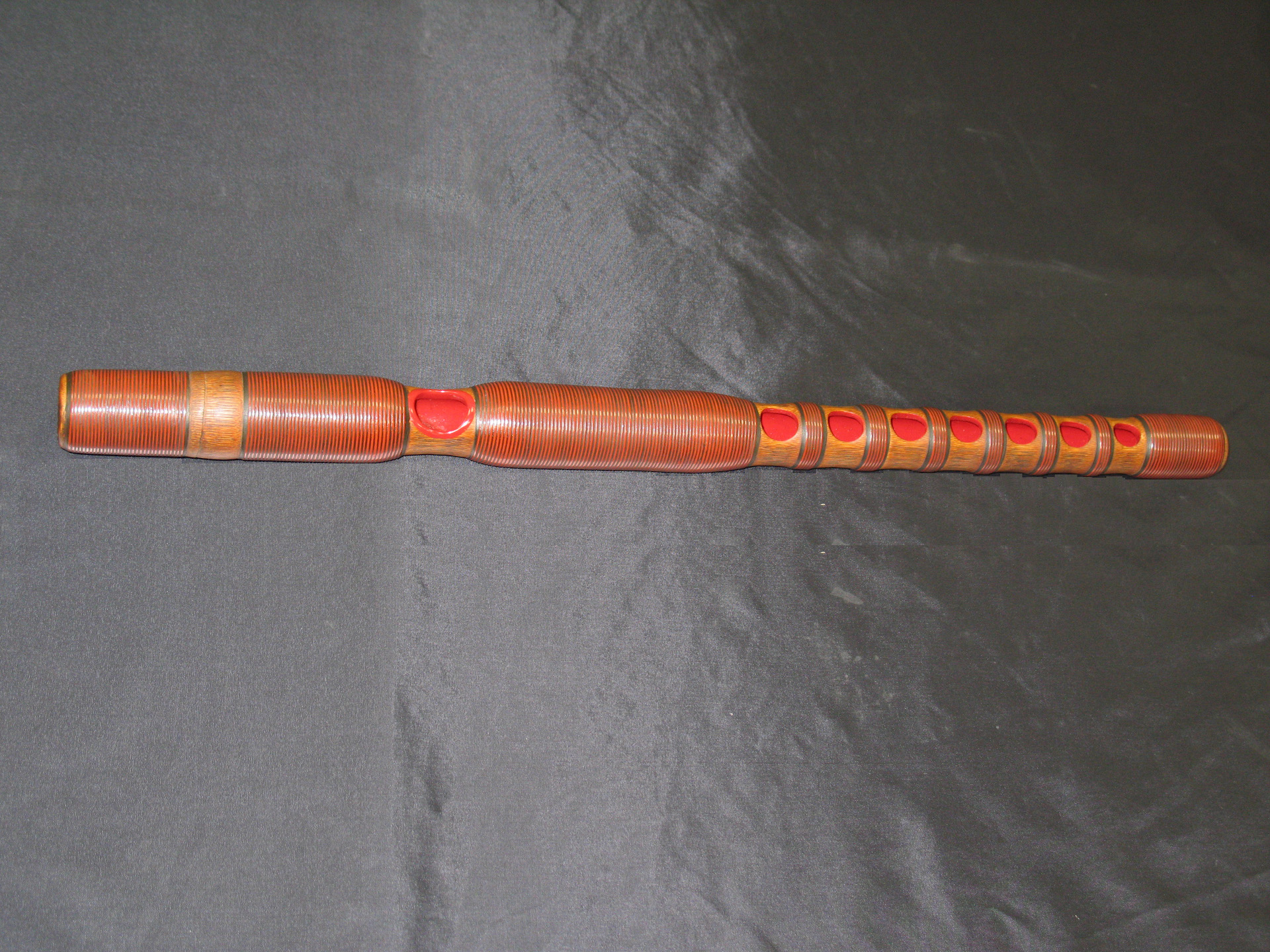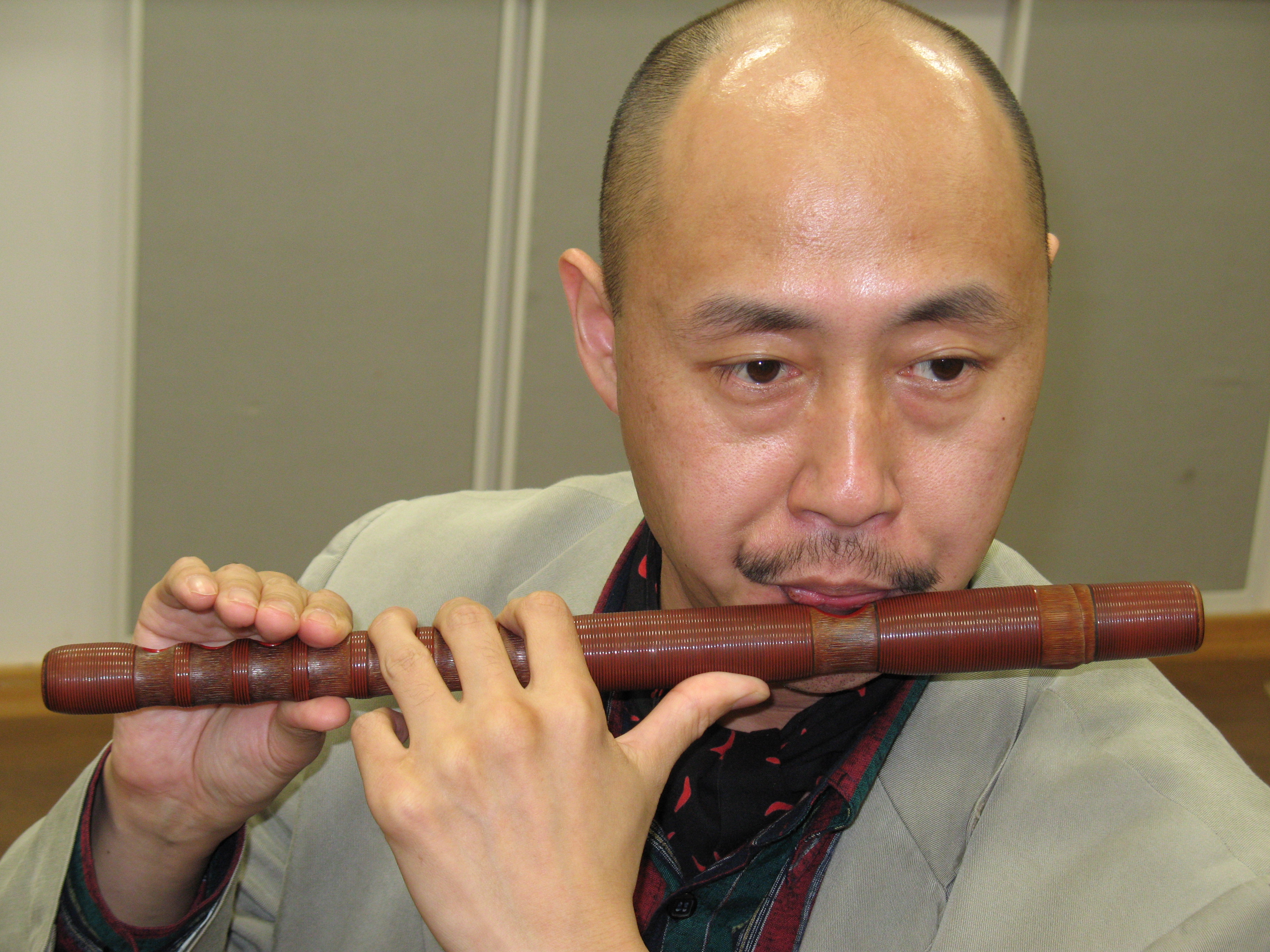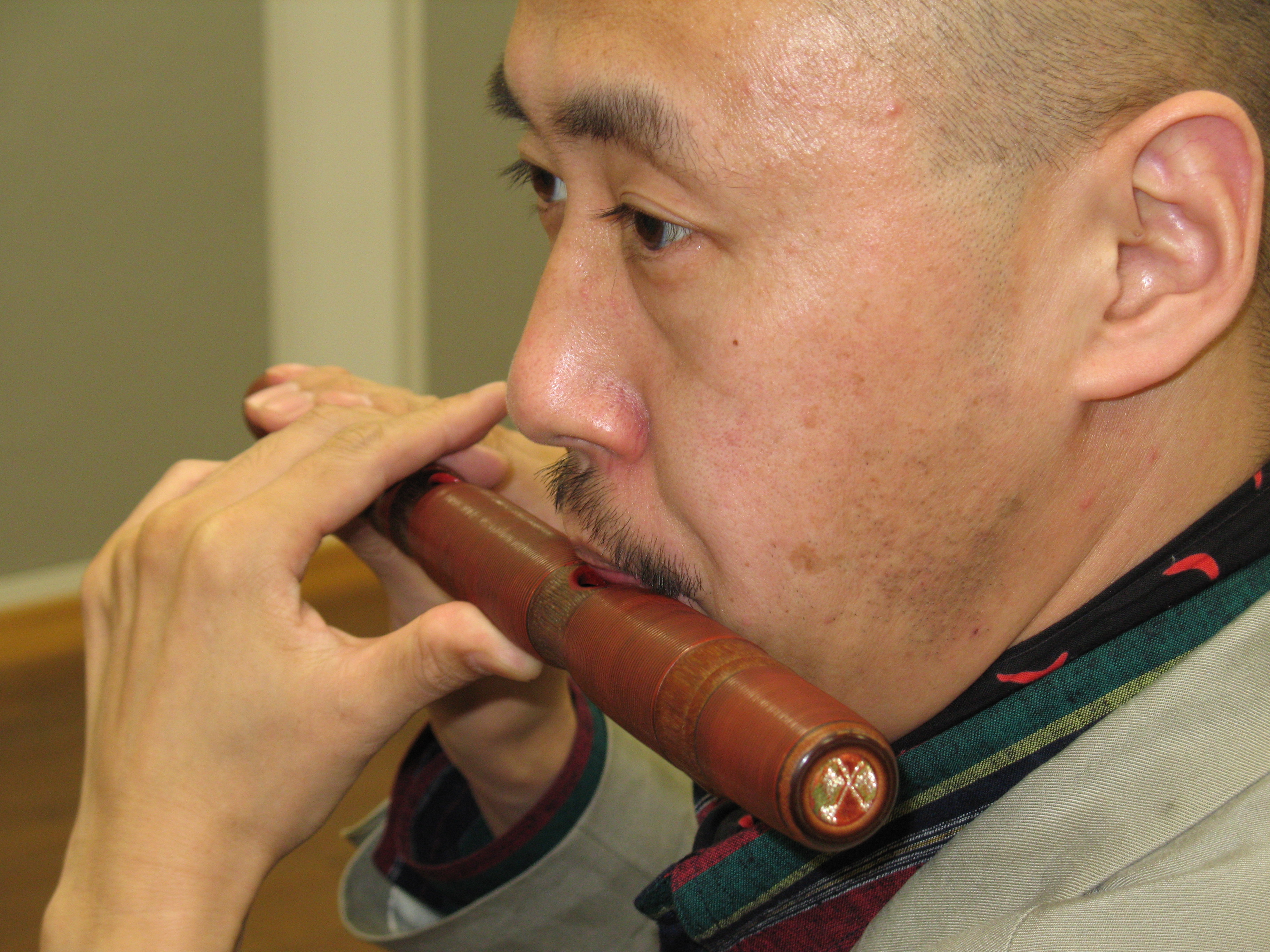Description
The ryūteki is a seven-holed transverse flute made of bamboo. It is approximately 40 cm long (16 inches). The inside of the bamboo is hollow and lacquered, and the outside is wrapped with strands of bark. The first three holes are assigned to the left hand fingers and the last four to the right hand. The embouchure is similar to a Western transverse flute. It is approximately 1.3 cm (0.5 inch) wide.
 Ryūteki
Ryūteki
Figure 1
 SASAMOTO Takeshi
Ryūteki – Fingerings
SASAMOTO Takeshi
Ryūteki – Fingerings
 SASAMOTO Takeshi
Ryūteki - Embouchure
SASAMOTO Takeshi
Ryūteki - Embouchure
Figure 2
Tuning and transposition
The ryūteki sounds one octave higher than written, and it is tuned to an A-430Hz.
Range and fingerings
Figure 3 shows that the range of the ryūteki goes from the written C#4 to F#6. The pitches shown in whole note are playable by opening/closing the instrument’s seven holes, while those in black are produced by 'half-holing', 'quarter-holing' (for the C5 and C6), or breath manipulation.
 Written range and fingerings for the ryūteki
Written range and fingerings for the ryūteki
Figure 3
Although the low C#5 and D#5 (written C#4 and D#4) are playable, they are never used in compositions since the quality of their timbre is rather poor as illustrated in Figure 4, which compares the spectra of the sound of the ryūteki playing ff a D#5 and E5 (written D#4 and E4, respectively). It shows that the spectrum of the E5 (in red) is richer, counting close to 9 partials compared with only 5 for the D#5 (in blue). Moreover, the higher peaks of the E5 indicate that its sound is stronger than the D#5. Consequently, the E5 (written E4) is considered to be the lowest pitch of the ryūteki’s register.

|
|
Spectra of the ryūteki playing ff a D#5 (in blue) and a E5 (in red)
Figure 4
The ryūteki does not have an octave key, so for any pitches in the second and third octaves, the performer uses its first octave’s fingering and overblows in order to transpose it an octave or two higher. Figure 5 shows how overblowing affects the sound’s quality. The top to bottom spectra of Figure 5 are those of the ryūteki playing ff an E5, E6, and E7 (written E4, E5, E6), and they are all produced using the same fingering. The black arrows from show that when overblowing the E5 (in blue) to get the E6 (in red), a trace of the E5 remains present in the sound of the E6.
The spectrum of the E6 (in red), which is the first pitch of the ryūteki’s prime register, shows that this register is richer in higher partials and more airy as suggested by the floating partials 2, 3, and 4.

|
|
Spectra of the sound of the ryūteki playing ff E5 (blue), E6 (red), and E7 (green) (written E4, E5, and E6 respectively)
Figure 5
Finally, the black and red arrows in the last spectrum of Figure 5, which represents the sound of the ryūteki playing ff an E7 (in green), shows remnants of the E5 and E6 in the sound of the E7 which is the first pitch of the ryūteki’s high register. It is because of these accumulated remnants that the higher register is unstable and can only be played loud. In other words, more pressure is required for playing the E7 in order to overcome the presence of the E5 and E6.
Traditional performance practices
- Articulation: Traditionally, tonguing is not used with Japanese wind instruments. Instead, phrases are shaped by control of the airflow, and selected pitches are accentuated by tapping the instrument’s holes with the fingers.
- Osu: Decrescendo followed by a sudden re-attack of the same pitch on a strong beat. The attack is not tongued but produced by an increase of the airflow.
- Ateru: Same effect as Osu but on weak beats.
- Osu and ateru can be performed on any pitches from the lower and prime registers.
| Osu | Ateru |

|
|
Example 1
- Orute: When a melodic line involves a motion from B5 to A5 (written B4 to A4) the B5 will chromatically slide to the A5, a motion called orute, and there is no prescribed material as to what precedes and follows it. Example 2 shows two separate cases.
| Orute |

|
Example 2
-
Kakebuki: Refers to four prescribed melodic motions:
- D6 on an upbeat leading to a downbeat on an E6 (written D5 to E5)
- G5 on an upbeat leading to a downbeat on a D6 (written G4 to D5)
- E6 on an upbeat leading to a downbeat on a G6 (written E5 to G5)
- B6 on an upbeat leading to a downbeat on a B6 (written B5 to B5)
| Kakebuki D6-E6 | Kakebuki G5-D6 |

|
|
Example 3a
| Kakebuki E6-G6 | Kakebuki B6-B6 |

|
|
Example 3b
- Tataku: This is the coloration of a sustained tone with the lower neighbor-tone. The change of fingering between the two pitches usually involves rapidly closing and re-opening a single hole, and tapping the hole on the closing. This accentuates the lower neighbor-tone. It can be performed on any pitch from the lower and prime registers.
- Ugoku: This is the opposite of tataku - the melodic motion involves the upper neighbor-tone. Once again, fingering between the two pitches involves the rapidly opening and re-closing of a single hole, thereby accentuating the returning pitch. It can be performed on any pitch from the lower and prime registers.
| Tataku | Ugoku |

|
|
Example 4
- Mawasu: This melodic motion entails a change of fingering involving two holes. A pitch slowly slides to its upper-neighbor tone opening one hole, and then rapidly closing two holes to move to its lower neighbor tone, tapping the holes and thereby accentuating the last tone. It can be performed on any pitch from the lower and prime registers.
| Mawasu |

|
Example 5
Example 6 shows the basic melody of Etenraku's section B and C, and its rhythmic accompaniment. This shows how the ryūteki uses various patterns to color the melodic tones. The phrase structure consists of four measures each with four beats, and each section is composed of two phrases. The piece is in Hyō-jō mode (E Dorian) and the basic melody is centered on the pitches: E, B, and A, three of the four fundamental pitches of the Japanese modal system.
As shown in Exemple 6, the ryūteki uses its various patterns to color a sustained-tone or connect two consecutive melodic tones, and in doing so it adds rhythmic character to the basic melody. While the doubling of the basic melodic tones is rarely disturbed, measure 13 shows the melodic tones B - C#, (doubled by the other instruments) supported by the ryūteki's part with C# and D, respectively. We can speculate that the tension created by this clash might be helpful to 'move' the music from its cadence in the preceding measure to the one coming in measures 15 and 16.
The excerpt is performed by the ensemble Reigakusha.

 The basic melody of Etenraku's section B and C and how it is articulated by the ryūteki
The basic melody of Etenraku's section B and C and how it is articulated by the ryūteki
Example 6
New performance practices
- Articulation: Depending on the performer abilities, single, double, and triple-tonguing can be used, in addition to staccato.
- Flutter tongue: This is the common technique used by a flutist where the performer flutters his/her tongue to make the characteristic 'Frrrrr' sound. Performing an isolated alveolar trill while playing a pitch produces the effect. This technique is playable throughout the lower and prime register of the ryūteki.
- Tremolo: The ryūteki does not traditionally use tremolo, but it can be utilized in new music. The rule of thumb is to use tremolo between two pitches that do not involve awkward fingerings and that do not cross over different registers. It is not playable in the high register.
- Bisbigliando: This effect is produced by slightly transforming the color of a tone, usually accomplished by using alternative fingerings for the same pitch. It can be played on any pitch from the lower and prime registers. It is produced by the use of special fingerings or with the motion of the lips.
- Harmonics: The ryūteki already overblows at the octave, but it can also overblow at the octave and a fifth, bringing out a pitch’s third harmonic. Its playability is limited to the following four pitches, and the effect requires a lot of air, so it can only be played loud. The sound excerpt of Example 7 is limited to the E5-B7 harmonic (written E4-B6).
| Harmonics |
 (Only the harmonics E5-B7 appears on the recording)
(Only the harmonics E5-B7 appears on the recording)
|
Example 7
- Karu and meru: This is a glissando motion done by the lips, karu means to slide up, while meru means to slide down. They can be performed over any pitch from the lower and prime registers. The precise amount of change in the glissando needs to be discussed with the performer.
| Karu & meru |

|
Example 8